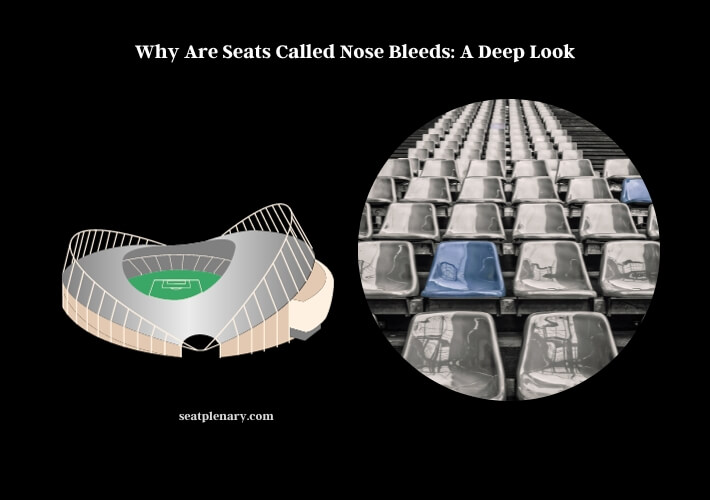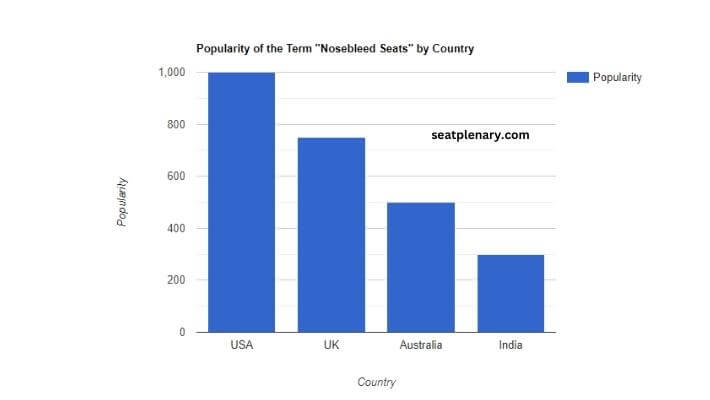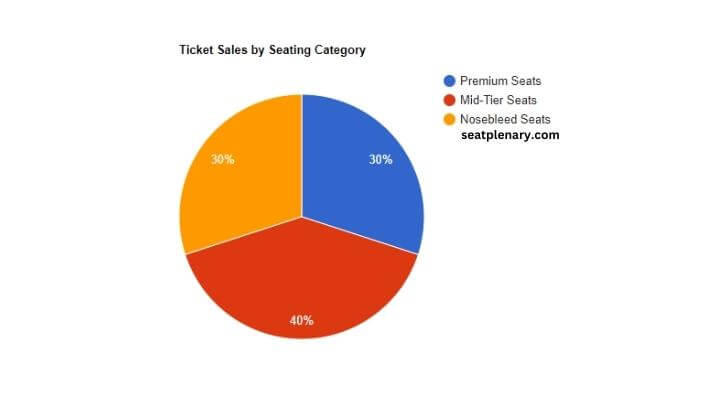Why are seats called nosebleeds? The term originates from the idea that higher altitudes, like those of mountain peaks, can induce nosebleeds. This concept is humorously applied to the uppermost seats in a stadium, suggesting they’re so high up that one might get a nosebleed.
Nosebleed seats, often found in the upper tiers of stadiums, are colloquially named due to their significant height and distance from the main action. This playful terminology draws a parallel between the high-altitude effects on mountain climbers and the lofty seating positions in large venues. While these seats might be far from the stage or field, they offer a unique vantage point and are typically more affordable than closer options.

Contrary to nosebleed seats, the opposite seating areas are typically referred to as premium or floor seats. These are closer to the action and are often sought after for their unparalleled views. Over the years, many artists and tours, including Taylor Swift and the Eras Tour, have seen fans flocking to both these premium spots and the nosebleed sections. Each offers its own unique concert or game experience.
For those intrigued by the history and nuances of stadium seating, we invite you to delve deeper into the detailed article below.
Why Seats High Up Are Dubbed Nosebleeds?
Historical Origins of the Term
Ever wondered how the term “nosebleed seats” came into existence? Stadiums have been around for centuries, and with them, a myriad of terminologies. The phrase “nosebleed seats” didn’t just pop up overnight. Its roots trace back to the early days of stadium constructions, where the highest seats were often the cheapest and farthest from the action. As time went on, this playful term began to stick, painting a vivid picture of just how high up these seats were.
The Science Behind Altitude and Nosebleeds
Alright, let’s get a bit scientific here. The higher you go, the thinner the air becomes. This can lead to less oxygen reaching your lungs and can cause capillaries in your nose to burst. Hence, the term “nosebleed” isn’t just a quirky phrase; there’s some real science behind it! So, while you’re catching your breath watching a game from the top, remember, it’s not just the thrilling match causing that light-headed feeling!
Cultural References and Popularity
From Hollywood movies to chart-topping songs, the term “nosebleed seats” has made its mark. Think about the last concert you attended or that sports movie you watched. Chances are, this term was thrown around, highlighting the distance and height of the seats. It’s a term that resonates with many, often with a touch of humor or nostalgia, reminding us of times we watched our favorite events from way up high.
Comparing Seat Prices: From Ground to Sky
| Seating Category | Average Price ($) |
| Premium Seats | 250 |
| Mid-Tier Seats | 150 |
| Nosebleed Seats | 50 |
Money talks, right? As you move higher up in a stadium, ticket prices generally decrease. Premium seats offer an up-close experience, hence the hefty price tag. On the other hand, nosebleed seats, while offering a bird’s-eye view, are easier on the wallet. It’s all about what experience you’re after and how much you’re willing to shell out.
The View from Above: Pros and Cons
Being way up there isn’t all bad. For starters, you get a panoramic view of the entire stadium. It’s like watching the event in widescreen! But, of course, there’s the tiny detail of players looking like ants. And let’s not forget the trek to get to these seats. But hey, think of it as a mini workout, and the reward? A view that’s truly one of a kind.
Global Perspective: Nosebleed Seats Around the World
Bar Chart:

The term “nosebleed seats” isn’t just a Western thing. It’s recognized globally, albeit with regional twists. The chart above showcases its popularity in different countries. While some nations have their own unique terms, the sentiment remains the same: these seats are way up there!
The Impact of Stadium Design
Stadiums have evolved over the years, and with them, the experience they offer. Earlier designs had steeper inclines, making the topmost seats feel even higher. Modern designs aim to offer a more immersive experience, even for those seated in the nosebleeds. So, while the term remains, the experience of sitting in these seats has transformed, all thanks to innovative architectural feats.
Nosebleed Seat Calculator: Is the Height Worth the Price?
Enter Ticket Price ($): Enter Seat Height (meters):Want to know if those high-up seats are worth your bucks? Use the calculator above! Just input the ticket price and the height of the seat, and voila! You’ll get a value-for-money score. Remember, it’s not just about the view; it’s about the experience and memories you’ll create.
Visualizing the Popularity of Nosebleed Seats

Ever thought about how many people actually opt for nosebleed seats? The pie chart above gives a glimpse into ticket sales by seating category. It’s fascinating to see how seating preferences vary among event-goers. Some chase the thrill of being up close, while others are content with a distant, panoramic view.
Frequently Asked Questions (FAQs)
What’s the Origin of the Term “Nosebleed Seats”?
The term “nosebleed seats” has its roots in the idea that higher altitudes can induce nosebleeds. Drawing a parallel, the uppermost seats in stadiums are humorously likened to such high altitudes, suggesting they’re so elevated that one might experience a nosebleed. Over time, this playful term gained traction and is now widely recognized.
Are Nosebleed Seats the Cheapest in a Stadium?
Typically, yes. Nosebleed seats are often the most affordable ticket options in a stadium. They’re located in the upper tiers, farthest from the main action or stage. Due to their distance and the obstructed views they sometimes offer, they’re priced lower than seats closer to the ground or stage.
Do People Actually Get Nosebleeds in These Seats?
While the term “nosebleed seats” suggests a connection between high altitudes and nosebleeds, it’s mostly a humorous exaggeration. In reality, the chances of someone getting a nosebleed solely because they’re seated in the upper tiers of a stadium are minimal. The term is more about emphasizing the height and distance of the seats.
How Do Nosebleed Seats Compare to Premium Seats?
Nosebleed seats are at the opposite end of the spectrum from premium seats. Premium seats, often located on the ground level or close to the stage, offer an up-close experience and are priced higher. In contrast, nosebleed seats provide a panoramic but distant view and are more budget-friendly.
Why Would Someone Choose Nosebleed Seats?
There are several reasons. For many, it’s a budgetary choice. Nosebleed seats are more affordable, allowing fans to attend an event without breaking the bank. Additionally, some people prefer the panoramic view these seats offer, especially in sports events where they can see all the action unfold from a bird’s-eye perspective.
Have Any Famous Events Popularized the Term?
Yes, the term has been mentioned in popular culture, including movies, songs, and TV shows. Various artists, concerts, and sports events have seen fans and commentators use the term, further embedding it in modern lingo. Its frequent use in media and by celebrities has played a role in its widespread recognition.
Is the Term “Nosebleed Seats” Used Globally?
While the sentiment behind the term is understood globally, different cultures might have their unique phrases or terms for high-altitude seats. However, with the globalization of media and entertainment, the term “nosebleed seats” has gained recognition in many parts of the world.
So there you have it, folks! From the quirky origins of the term “nosebleed seats” to the science behind it, and its global recognition, it’s clear that these seats are more than just a place to sit. They’re a cultural phenomenon, a testament to human ingenuity in stadium design, and a reminder that sometimes, the best views come from way up high. Whether you’re a fan of these seats or not, one thing’s for sure: they’ve earned their place in history. And who knows? The next time you’re up there, you might just feel on top of the world!
